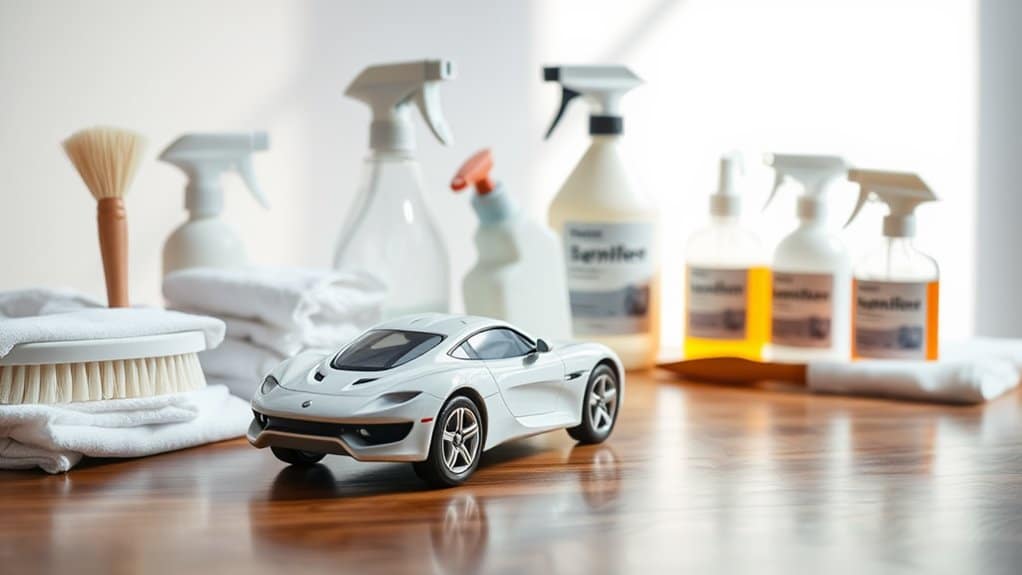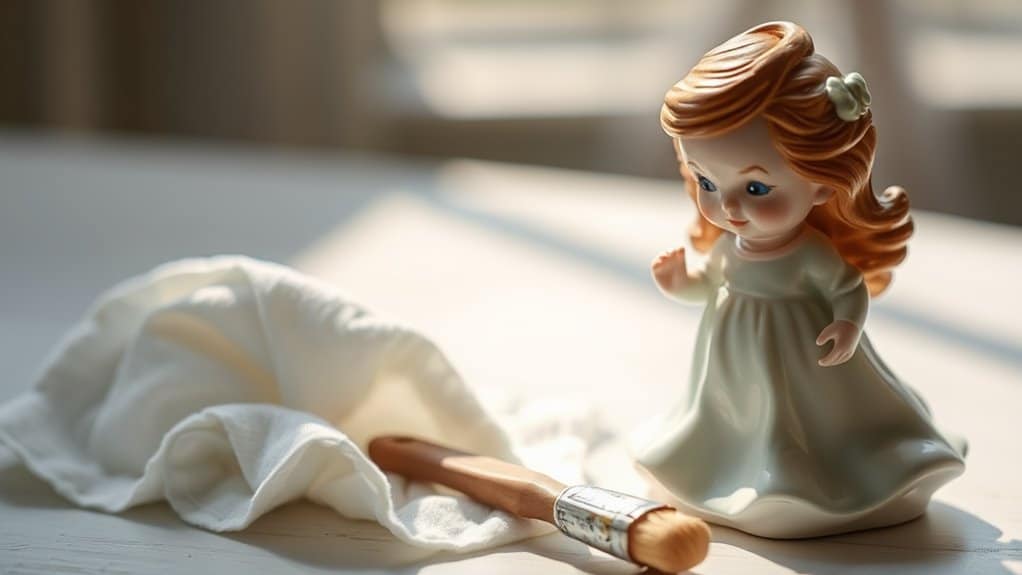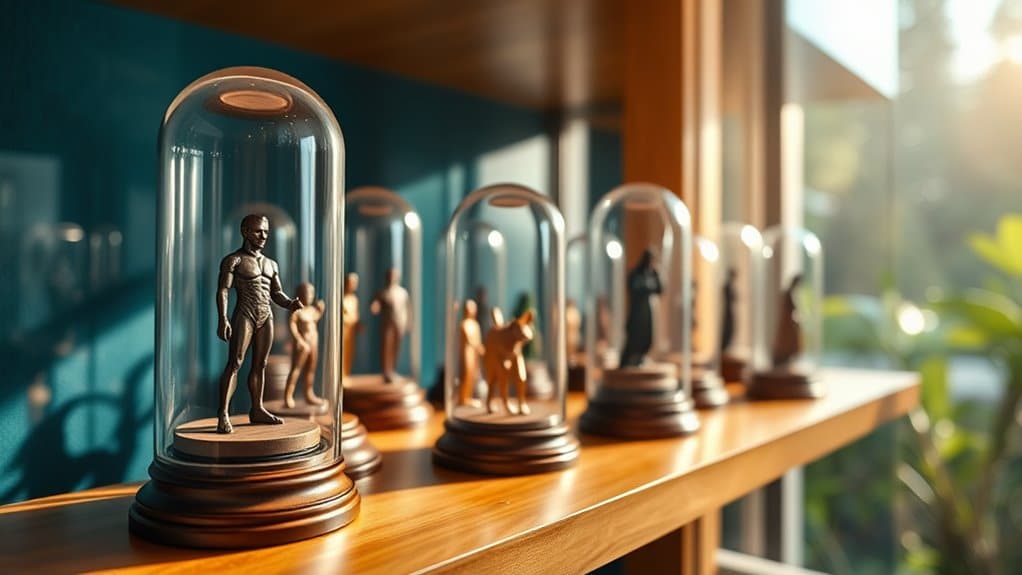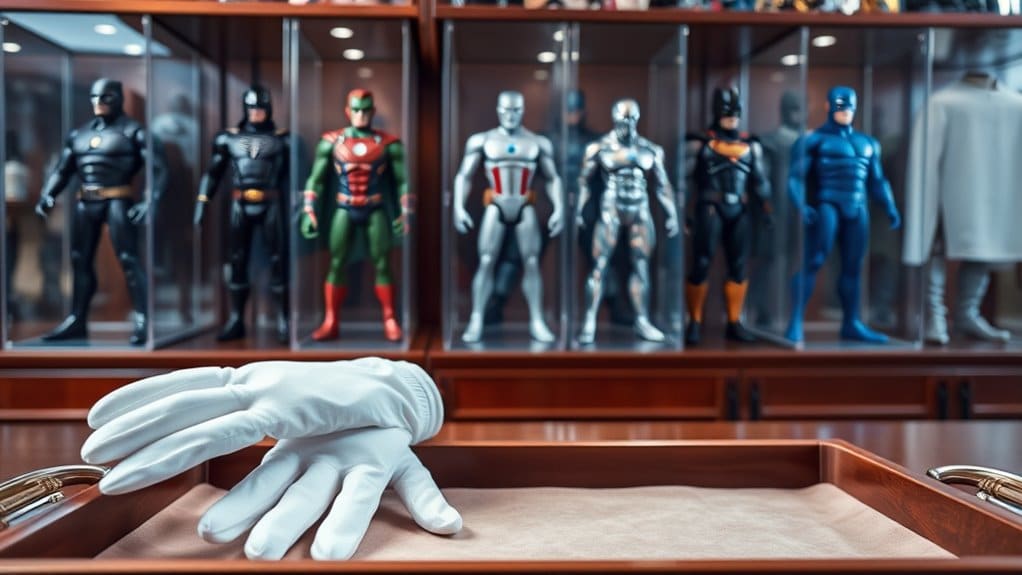To clean your coated toy models, start by identifying the type of coating—acrylic, enamel, or lacquer—since cleaning can vary. Gather supplies like microfiber cloths and soft brushes to gently remove dust without scratching. Assess your model under good lighting for dirt or damage. Use gentle circular motions for cleaning and avoid harsh chemicals. Proper drying and storage will maintain longevity. Keep exploring to uncover more detailed techniques and advice.
Understanding the Types of Coatings on Toy Models
When you're diving into the world of toy models, it's crucial to understand the different types of coatings that manufacturers use. These coatings not only enhance the model's appearance but also protect it from wear and damage. You'll encounter several common types: acrylic, enamel, and lacquer. Acrylic coatings are water-based, offering easy application and quick drying. They're favored for their vibrant colors. Enamel coatings provide a durable, glossy finish, making them ideal for models subject to frequent handling. Lacquer coatings are known for their high sheen and durability, but they require careful application due to their sensitivity to humidity. Knowing these coatings helps you appreciate the model's craftsmanship and guides you in maintaining their pristine condition. Understanding coatings transforms your model care approach.
Essential Cleaning Supplies for Coated Toy Models
Knowing the type of coating on your toy model is just the beginning. Now, you need the right cleaning supplies to guarantee that your model stays pristine. Start with a set of microfiber cloths—they're gentle and won't scratch delicate surfaces. You'll also want a soft-bristle brush to reach those tricky spots and remove dust without damaging the coating.
For cleaning solutions, avoid anything harsh. Mild, water-based cleaners or specialized model cleaners are your best bet. If you're unsure, test a small, hidden area first. Cotton swabs are handy for precision cleaning in tight spots. Finally, grab a can of compressed air to blow away dust from intricate details. With these supplies, you're ready to keep your coated toy models looking their best.
Preparing Your Workspace for Cleaning
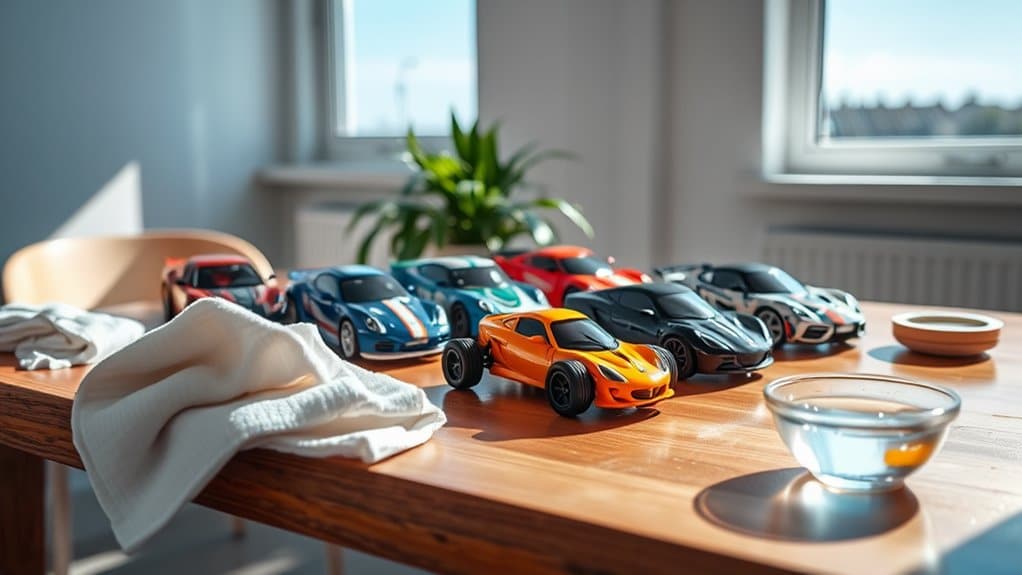
Before diving into cleaning your toy models, it's important to set up a workspace that's organized and efficient. You want everything within arm's reach, so you can focus on making your models shine. Clear a table or desk with sufficient lighting to see every detail. Make sure to cover your workspace with a soft cloth or mat to prevent scratches.
Keep these essentials nearby:
- Cleaning Supplies: Gather your brushes, microfiber cloths, and mild cleaning solutions.
- Storage Containers: Use small trays or boxes for storing delicate parts and accessories.
- Waste Disposal: Have a small trash bin handy for any debris or used materials.
With your workspace ready, you'll find the cleaning process smoother and more enjoyable. Now, you can focus on giving your models the care they deserve.
Assessing the Condition of the Coated Toy Model
How do you determine the state of your coated toy model before cleaning? Start by examining the surface under good lighting. Look closely for any visible dust, dirt, or fingerprints. Check for signs of wear, such as scratches, chips, or peeling in the coating. Pay attention to areas where parts join, as grime can build up in crevices. Gently touch the model to feel for sticky or oily residues, indicating the need for thorough cleaning. Inspect fragile components and moving parts to verify they're intact. Note any loose or delicate sections that might need special care during cleaning. By evaluating its condition, you'll know exactly how to proceed without causing damage, guaranteeing your model stays in top shape.
Gentle Dusting Techniques for Surface Cleaning

When you're ready to gently dust your toy models, start by selecting a soft brush that won't scratch delicate surfaces. Use a microfiber cloth to capture fine particles without leaving lint behind. For those hard-to-reach areas, a quick burst from a can of compressed air can effectively blow away stubborn dust.
Soft Brush Selection
A soft brush is an essential tool for gently dusting toy models without causing damage. When selecting a brush, you'll want to verify it has soft bristles to avoid scratching delicate surfaces. Look for brushes designed for art or makeup, as they're typically gentle and effective. Consider these features when choosing your brush:
- Bristle Material: Opt for natural or high-quality synthetic bristles that are soft yet durable.
- Size: A small to medium-sized brush offers better control and access to detailed areas.
- Handle Design: Choose a comfortable grip, so you can maneuver easily around your models.
Regular dusting with the right brush helps maintain the appearance of your models and prolongs their life. Remember, gentle strokes are key to preserving their intricate details.
Microfiber Cloth Use
Even though toy models can collect dust over time, using a microfiber cloth is a fantastic way to keep them clean and pristine. Begin by gently unfolding your cloth to cover a large surface area. Hold the toy model securely and use light, circular motions to capture dust without applying too much pressure. This minimizes the risk of scratching delicate surfaces or damaging intricate details. Microfiber cloths are great because they trap dust effectively without spreading it around or leaving lint behind.
Make sure your cloth is clean; a dirty one might transfer grime back onto your model. Wash it regularly following the care instructions to maintain its effectiveness. Always store your microfiber cloth in a dry, dust-free area to keep it ready for your next cleaning session.
Compressed Air Application
Blast away stubborn dust particles with the power of compressed air, a handy tool for keeping your toy models spotless. It's perfect for reaching those intricate nooks and crannies where dust loves to hide. Just remember, using compressed air requires some precision. Keep these tips in mind:
- Hold the can upright: Tilting it might release liquid propellant, which can damage your model.
- Short bursts: Quick, controlled blasts are more effective and prevent moisture buildup.
- Safe distance: Maintain at least a 6-inch gap to avoid applying too much pressure.
Always test on an inconspicuous area first to verify compatibility with your model's coating. Regular use of compressed air not only maintains your models' appearance but also extends their lifespan by preventing dust accumulation.
Safe Solutions for Deep Cleaning Coated Surfaces
When it comes to deep cleaning coated surfaces on toy models, guaranteeing the safety of the finish is essential. You want to maintain the model's integrity while removing dirt and grime. Start with a gentle solution of mild dish soap and lukewarm water. Mix a few drops of soap into a bowl of water and use a soft, lint-free cloth or microfiber towel. Gently dab the surface, avoiding excessive moisture. For stubborn spots, you can use a soft-bristled brush. Avoid harsh chemicals like ammonia or alcohol-based cleaners as they can damage the coating. Rinse with a clean, damp cloth to remove soap residue. Always test your cleaning solution on a small, inconspicuous area first to guarantee it's safe.
Drying and Storing Cleaned Toy Models
After you've meticulously cleaned your toy models, ensuring they're properly dried is essential to prevent damage. Use a soft cloth to gently blot excess moisture, and let them air dry completely. Once dry, store them in a dust-free environment, like a display case or a dedicated shelf, to keep them looking pristine.
Proper Drying Techniques
Making certain your toy models are thoroughly dried after cleaning is essential to maintaining their condition and longevity. Start by gently patting them with a soft, lint-free cloth to remove excess moisture. Avoid using heat sources like hair dryers, as they might damage the coating. Instead, let them air dry naturally in a well-ventilated area. Remember, proper drying prevents mold and preserves the finish.
Consider these tips for effective drying:
- Air Circulation: Place models in a space with good airflow to expedite drying.
- Avoid Direct Sunlight: Sun exposure can cause fading or warping.
- Elevate Models: Use a drying rack to make certain all sides dry evenly.
Safe Storage Solutions
Once your toy models are thoroughly dried, it's important to store them properly to maintain their pristine condition. Start by choosing a cool, dry location away from direct sunlight, which can fade colors and damage coatings. Use airtight containers to protect them from dust and moisture. You might want to take into account storing them in a display case if you prefer to showcase them. This keeps them safe while allowing you to admire their beauty.
Avoid stacking models on top of each other, as this can lead to scratches or deformations. Instead, use dividers or individual compartments to keep them separated. If you're storing them for an extended period, check periodically for any signs of damage or moisture buildup. Proper storage guarantees your collection stays immaculate.
Avoiding Common Cleaning Mistakes
When cleaning toy models, it's easy to make mistakes that can damage your prized pieces. To keep them in pristine condition, you'll need to avoid common pitfalls. For starters, never use harsh chemicals or abrasive materials—they can strip away the coating and ruin the finish. Instead, opt for gentle cleaning solutions and soft cloths. Also, avoid soaking your models in water. Excessive moisture can warp the material and cause paint to peel.
Here's what you should avoid:
- Excessive Scrubbing: Gentle wiping is enough; scrubbing can scratch surfaces.
- Using Unverified Cleaners: Stick to recommended products to prevent chemical damage.
- Neglecting Delicate Parts: Pay close attention to fragile areas; they're more prone to breakage.
Maintenance Tips for Prolonging Coating Longevity
Preserving the pristine condition of your toy models doesn't stop at careful cleaning; maintaining the coating's longevity is equally important. First, keep your models away from direct sunlight. UV rays can fade colors and weaken coatings over time. Store them in a cool, dry place to prevent moisture buildup, which can lead to peeling or bubbling. Dust them regularly with a soft, lint-free cloth to avoid scratches. Avoid using harsh chemicals or abrasive materials during cleaning, as they can damage the protective layer. Rotate your display occasionally to guarantee even exposure to environmental elements. Finally, handle your models with clean hands to prevent transferring oils and dirt. These simple steps can help guarantee your toy models remain vibrant and well-protected.
When to Seek Professional Restoration Services
When your toy model shows signs of damage like cracks or chipped paint that cleaning can't fix, it's time to contemplate professional restoration. You'll need to evaluate the restoration costs against the model's sentimental or market value. Seeking expert help can guarantee your cherished piece is preserved with care and expertise.
Identifying Damage Signs
Even though toy models are cherished treasures, they can suffer damage over time that requires careful attention. Identifying signs of damage early can prevent further deterioration and help you decide when to seek professional restoration. Keep an eye out for these common issues:
- Cracks or Chips: Inspect surfaces for visible cracks or chips, which can worsen if left untreated.
- Fading Colors: Notice any significant fading or discoloration, indicating that the model's protective coating is compromised.
- Loose Parts: Check for parts that feel wobbly or detached, as they can lead to further structural damage.
Spotting these signs early means you can act swiftly, preserving your model's integrity. When in doubt, consult a professional to avoid accidental damage during home repairs.
Weighing Restoration Costs
After identifying damage signs in your cherished toy models, you might wonder about the costs of restoration and whether professional services are necessary. First, evaluate the extent of the damage. Minor scratches or dust can often be handled with DIY methods, saving you money. However, when models have significant paint chipping, structural damage, or intricate details that need expert care, it's wise to consult a professional. Consider the model's value—both sentimental and monetary. If it's a rare or expensive piece, professional restoration can maintain or even enhance its value. Research service providers for quality and cost comparisons. Weighing your options guarantees you're making informed decisions about preserving your collection without overspending or settling for subpar results.
Frequently Asked Questions
Can Cleaning Methods Differ for Vintage Toy Models?
Yes, cleaning methods can differ for vintage toy models. You'll want to be extra careful with them. Always test a small area first, use gentle cleaning agents, and avoid harsh chemicals that might damage the delicate surfaces.
How Do I Identify the Type of Coating on My Toy Model?
To identify your toy model's coating, channel your inner Sherlock and examine its surface. Look for glossy or matte finishes, tap lightly with a penny to test hardness, and consult manufacturer details online or in original packaging.
Are There Specific Tools for Cleaning Intricate Model Details?
Yes, you can use soft brushes and microfiber cloths to clean intricate model details. Cotton swabs help reach tight spots, while compressed air removes dust. Avoid harsh chemicals, ensuring you don't damage delicate parts or coatings.
What Should I Do if I Accidentally Damage the Coating?
Imagine a small crack in a glass surface. You'd gently smooth it with sandpaper. In your case, touch up the damaged area with matching paint, ensuring you blend it seamlessly for a flawless finish.
Can I Use Household Items for Cleaning Toy Models?
Yes, you can use household items like mild soap and warm water to clean toy models. Avoid harsh chemicals and abrasive materials. Gently scrub with a soft cloth or brush to maintain the model's integrity.
At a Glance
In caring for your coated toy models, think of yourself as a guardian of tiny treasures. With the right tools and techniques, you'll guarantee these miniature marvels remain vibrant and intact. Remember, gentle handling and regular maintenance are like nourishing rain to a garden, keeping your collection flourishing. Avoid pitfalls by evaluating each model's needs, and don't hesitate to seek professional help when necessary. Your diligence will keep these cherished pieces shining for years.
